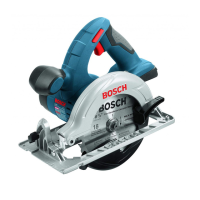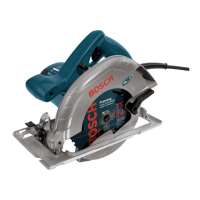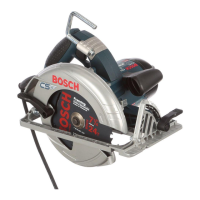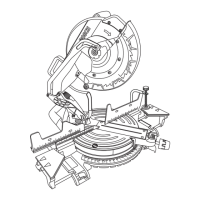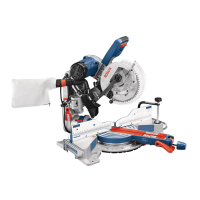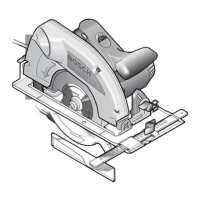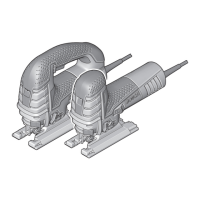90°
-12-
Disconnect battery pack
from tool before making
any assembly, adjustments or changing
accessories. Such preventive safety measures
reduce the risk of starting the tool accidentally.
▶ Depth Adjustment
Disconnect battery pack from tool. Loosen the
depth adjustment lever located on the right side of
the tool. Hold the foot down with one hand and raise
or lower saw by the handle.
Tighten lever at the depth setting desired. Check
desired depth (Fig. 4).
Not more than one tooth length of the blade should
extend below the material to be cut, for minimum
splintering (Fig. 5).
▶ 90° Cutting Angle Check
Disconnect battery pack from tool. Set foot
to maximum depth of cut setting. Loosen bevel
adjustment lever, set to 0° on quadrant, retighten
lever and check for 90° angle between the blade and
bottom plane of foot with a square (Fig. 6). Make
adjustments by turning the small alignment screw
from bottom side of foot, if necessary (Fig. 7).
▶ Bevel Adjustment
Disconnect battery pack from tool. The foot can
be adjusted up to 50° by loosening the bevel
adjustment knob at the front of the saw. Align to
desired angle on calibrated quadrant. Then tighten
bevel adjustment knob (Fig. 8).
Because of the increased amount of blade
engagement in the work and decreased stability
of the foot, blade binding may occur. Keep the saw
steady and the foot firmly on the workpiece.
▶ Line Guide
For a straight 90° cut, use left side of notch in the
foot. For 45° and 50° bevel cuts, use the right
side (Fig. 9). The cutting guide notch will give an
approximate line of cut. Make sample cuts in scrap
lumber to verify actual line of cut. This will be helpful
because of the number of different blade types
and thicknesses available. To ensure minimum
splintering on the good side of the material to be
cut, face the good side down.
Operating Instructions
Fig. 4
DEPTH
ADJUSTMENT
LEVER
CALIBRATED DEPTH
BRACKET
Fig. 5
ONE TOOTH LENGTH SHOULD
PENETRATE WOOD FOR
MINIMUM SPLINTERING
Fig. 8
BEVEL
ADJUSTMENT
KNOB
QUADRANT
